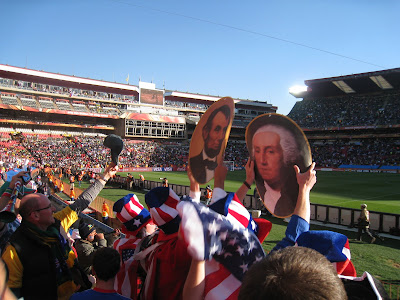After bidding
Sinterklaas farewell and stopping for gas in Naboomspruit/Mookgophong, we headed down the N1 to Johannesburg. Even before accounting for the gas (expensive at 500+ rand to fill up), the drive cost us over 100 rand. Outside the big cities, South African highways have numerous toll stops, with prices ranging from 7.5 to 43 rand.
Bill's decision to ignore our directions and take the poorly signed M1 highway into town served us well, getting us to the hotel at noon, perhaps 20 minutes or more before we would have if we had followed the directions. Stupid Google Maps. Good thing we got to the Protea Hotel Wanderers when we did, because a "rock star" parking spot, early check-in, and a van about to head to Ellis Park were all available. We threw our bags in the room, making sure to grab our sunglasses, Stars-and-Stripes flags, camera, and a leftover six-pack of Castle Lager. It was a beautiful, bright, crisp day, perfect for a ball game--reminiscent of a college football Saturday back in the States.
The USA fans in the bus were nice enough to wait for us, so we thanked a few of them with Castle Lagers, a great way to make friends. Paul and Vic, a couple of guys traveling together from Cleveland and North Jersey, respectively, turned out to be kindred spirits. Vic had a friend with knowledge of a pre-game party at Joe's Bar, at the corner of Dawe and Bezuidenhout. Unfortunately, it is on the other side of Ellis Park from where the bus let us off, so we had a 20-minute hike. Here is a picture of the Ponte City Apartments, the tallest building in Johannesburg, and on the northern side of the Ellis Park neighborhood...

Almost immediately, we saw some Slovenia fans in full effect. Idrija is a small mining town in Slovenia..

Bill got interviewed on camera by Mexico's Telefutura along the way; apparently, there are enough USA fans back in Mexico to merit a news crew. No word on whether his Spanish-language interview ever aired. A bit later we found ourselves in a primarily Nigerian neighborhood with lots of body shops. Not the nicest section of town, but nobody gave us any trouble; to the contrary, the locals often gave us a smile, thumb-up, and an approving "Go, USA!" Nice to know not everybody in the world hates us.
Finally, and mercifully, we made it to Joe's. It was worth the hike. Inside, we found a large American contingent and a table of Slovenians. It wasn't quite the 150:1 United States to Slovenia population ratio, but it was close. Here's a popular Slovenian t-shirt--pretty unintimidating if you ask me. C'mon, man...it's a World Cup match, not a tourism commercial...

To tell what kind of place it is, here are the rules posted on the wall. Pretty funny...

Over more Castles and delicious pub grub (lamb stew), we learned Paul had attended every USA World Cup game since 2002. He says both his boss and his wife are very accommodating--his wife wanted to come but was back in Cleveland with a six-month-old! Furthermore, to every game, he had worn the same hideous-but-strangely-poignant, 9/11-themed "United We Stand" shirt that someone had given him in Korea after purchasing it in Times Square. Once the USA made it to the quarterfinals that year, it became his good luck charm. Here's Bill and his
mustache with Paul and his shirt...

There was a local guy in the bar trying to make a few rand by selling worthless Zimbabwean dollars as a tourist novelty. Bill bought a 10-Billion dollar bill for 20 rand. Minutes later, Vic paid the same amount for a 50-Billion dollar bill. Inflation in Zimbabwe is bad, but a 400% increase in a matter of minutes is ridiculous.
Meanwhile, Serbia's remarkable upset of Germany played on the telly. Looking back, it's hard to believe Die Mannschaft couldn't even score on the otherwise lame Serbs.
An hour before the 4:00 game, it was time to buy my own personal
vuvuzela to take into the stadium. Here are Bill and me (and our mustaches) with my new horn, inscribed with "2010 IS MY YEAR," which I found highly appropriate...











































